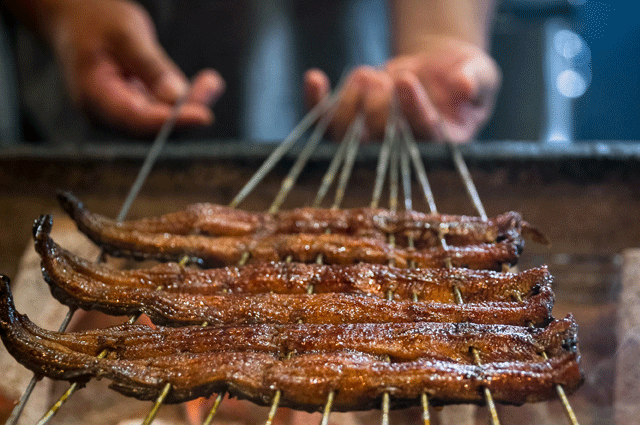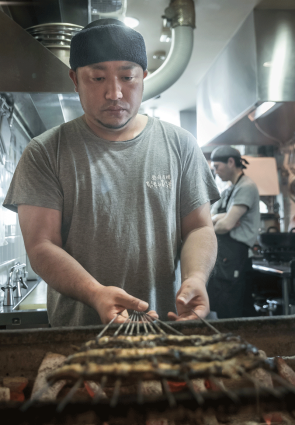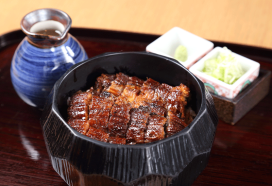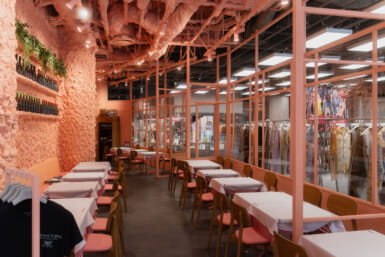The chef trainer behind the Nagoya-based franchise reveals the secret that has made Hitsumabushi Bincho a favorite of food lovers around the country.
For many years, one part of the life of the Japanese eel (Anguilla japonica) was shrouded in mystery. It was known that, once they were born, the eel young would make their way to the rivers of Japan, Korea, Taiwan, and Vietnam. After growing to maturity, they would eventually make their way back to their salt water spawning grounds. But exactly where they spawned was never clear. A team of researchers—who, given their dedication, were probably big fans of unagi, as the Japanese freshwater eel is known—were able to establish with some distinction exactly where they were making their thousands-of-mile journeys to continue the species.
Not only are the eels returning to an area some few hundreds of square miles west of the Mariana Islands in the Pacific, they are also spawning just before the new moon each month. The young are swept along by the currents, bringing them to land, and eventually fresh water, where they will grow to maturity and repeat the cycle.
Given how particular the eel are about where and when they reproduce, it seems only fitting that the cooks at the Nagoya-based Hitsumabushi Bincho franchise prepare them with the same attention to detail. As Takashi Ibuki, head chef and chef trainer for the franchise, explained, there are many different details that must be considered when preparing an eel on the grill. And the grill is one of the things that separates Nagoya-style eel from the way it is prepared in other parts of Japan. Particularly around Tokyo, it is served steamed, which makes for a softer dish, but one with far less character. All it takes is one bite of grilled eel to be able to tell the difference. There’s a crunchiness in the beginning that makes for a firm, yet juicy consistency that is complemented by the rich sweetness of the kabayaki glaze. Finally, the oak grilling leaves its final mark on the dish: a smoky aroma that lingers on pleasantly.
Not All Eel Are Made Alike
But each eel cannot be prepared in exactly the same way, Ibuki explains; one of the ways to tell the difference is the color of the eel’s skin, which ranges from blue to dark brown. A trained chef will look at an eel with blue skin and recognize that it has a higher fat content than, say, a brown one; this means that the small details in preparation all need to be different: the bincho (Japanese oak) used as charcoal needs to be stacked in just the right way to achieve just the right height of flame and the perfect temperature; meanwhile, the flames need to be fanned correctly. An entirely separate set of details need to be applied for a leaner eel, and the eating experience will also be a different one. “That way, although a customer wouldn’t specifically ask for a certain kind of eel [leaner, or more fatty], but they would have the opportunity to discover the appeal and unique flavor of each one.”
For most people in Japan, unagi is a luxurious dish, but it is one that most people are familiar with, but Ibuki, a 22-year veteran with Hitsumabushi Bincho, has taken the time to consider the appeal of this dish for the Western palate, and come up with what he feels to be an apt analogy: “For foreigners who might not have had the chance to try unagi before, I’d like for them to consider it in the same way that they can enjoy a steak: there’s that flavor, that juiciness, but finally, there’s the smoky flavor that the oak charcoal imparts to the eel, that really makes a difference. It’s like the lingering after taste of a fine wine. That is something that I hold very dearly as a chef.”
The Edo Period Origins of a Signature Dish
Just as the grilling that bincho implies is part of the difference at the franchise, the other element that makes their signature dish unique is the way you eat it. While you can order unadon and unaju (a bowl or a flat box filled with rice and topped with eel, respectively), the best experience is to eat it hitsumabushi style: the eel is cut into small pieces, and served over rice in a large round dish. You eat it in three steps: First, you scoop about a third of your portion into a smaller bowl and mix the rice and eel together. Next, you then take another third, this time topping it with wasabi and green onions. Finally, you serve yourself the last helping, add seaweed, wasabi, and green onions, and finally pour dashi (broth) on top of all of it. Each stage lets you savor different qualities of these seemingly simple ingredients.
The story behind the specific style of Nagoya eel is also a unique one. Much like the humble origins of sushi, the hitsumabushi style comes from low beginnings, but has been elevated to culinary art thanks to the combination of great ingredients and the cook’s skill.
There are a lot of theories about how the hitsumabushi style got started, but one seems particularly likely: during the Edo period, it was a means of using parts of the eel that wouldn’t be served to customers—primarily the head. It was cut up and mixed with rice, and finally eaten with broth, seaweed, and wasabi. As is often the case, even when they rise in station, people never lose their taste for comfort food, and the basic serving style never changed, although the ingredients, and the attention to detail, improved considerably.
Passing on the Tradition
Ibuki, whose first love was soccer, thinks about training the next generation of Hitsumabushi cooks much like an innovative coach might think of training athletes with a strong potential. He doesn’t think that the way he first learned was the best way to do it. “At the beginning, I didn’t know anything, so my training was to just watch my senpai and imitate what he did. And if I made a mistake, he would get angry, but I wouldn’t necessarily know why. That way of learning takes a very long time, and sometimes a lot of time is wasted. Now, we work with our new staff more carefully, explaining the reasons for doing things the way that we do. Once they understand the reasons behind doing things in a certain way, they make very fast progress. It’s important to have that understanding that is intellectual as well as a kind of understanding that you feel directly in your body.”
Making the trip to Tokyo every two weeks—and visiting several other of Hitsumabushi Bincho’s other locations around Japan—Ibuki has plenty of opportunities to help the franchise’s cooks achieve a level of culinary excellence that you can recognize from the first bite.
Tokyo:
Tokyo Skytree Town | Tel: 03-5619-5757
Ikebukuro PARCO | Tel: 03-5956-5756
Ginza | Tel: 03-5159-0231
Nagoya:
Head Store | Tel: 0587-96-0141 LACHIC | Tel: 052-259-6703 Esca | Tel: 052-451-5557
Osaka:
Grand Front | Tel: 06-6371-5759
Fukuoka:
Nakasu Kawabata | Tel: 092-409-6522
Sponsored Post











